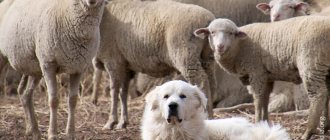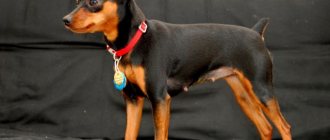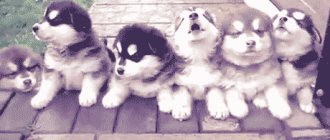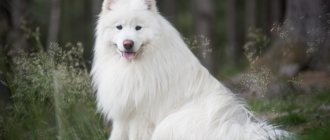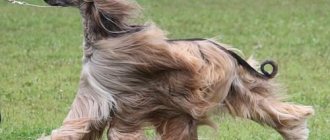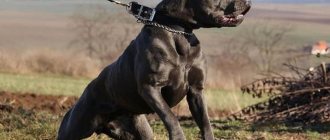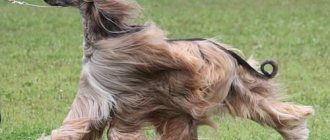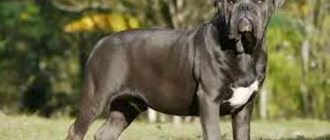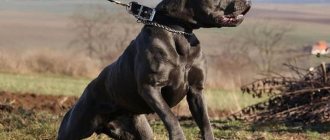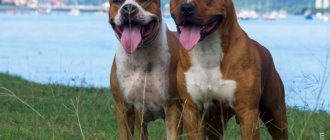The common wording “fighting breed” is not officially registered. It is more of an amateur designation for varieties of dogs that shared common physical and psychological qualities that made them suitable for fighting.
After this bloody entertainment was banned in many countries, the principles of breeding fighting dogs (also called gladiators) underwent changes. Breeders began to select individuals with the gentlest disposition for breeding in order to ultimately obtain a dog with a reduced level of aggressiveness. However, not all once formidable fighters succumbed to “re-education.” Many breeds still retain a ferocious temperament, especially if they were trained by non-professionals.
Bullmastiff
These dogs are absolute record holders for jaw clenching force. According to the calculations of dog handlers, this figure for bullmastiffs is 155 kg per square meter. cm.
These dogs can be called the result of a selection error. They were once bred in England to help foresters catch poachers. However, quite quickly the bullmastiffs were removed from service: they were excellent at finding violators, but often bit them to death. At the same time, in ordinary life, the dog, thanks to the efforts of breeders, no longer suffers from unmotivated aggression.
Bullmastiffs are strong and tall dogs. Their height at the withers reaches 70 cm, weight – 60 kg. They effectively use physical strength in battle: they try to knock the enemy down and grab the most tender places - the throat or stomach.
They have a tough temperament, are fierce and do not succumb to any tricks, which is why security forces often use them in special operations.
Features of training
Fighting dogs need to be trained from a very early age . These breeds are genetically programmed to be aggressive and want to get into fights, so puppies need socialization as early as possible. The pet will have to devote all his free time, walk with him every day for 2-3 hours (exclusively in a muzzle and on a leash), and provide him with the necessary level of physical activity. In the process of education and training, you must adhere to the following rules:
- always show your dominant and leading position, not allowing the dog to insist on its own (the owner must be an indisputable authority);
- if necessary, show rigidity and rigor;
- give commands correctly, clearly and firmly;
- do not use physical violence.
Fighting dogs must be trained
You should not leave small children with a fighting breed dog, as children can provoke a surge of aggression.
It is best to entrust the training of a dog prone to aggression to an experienced instructor who has experience in handling such animals . But the training process is not limited to one or even two completed courses; the dog will have to be trained throughout its life, while constantly keeping it under strict and vigilant control.
Bull Terrier
A compact but very strong dog with a well-deserved reputation as a killer. With a height of 30–40 cm at the withers and a weight of only 13 kg, the Bull Terrier will emerge victorious in a fight with almost any opponent.
A unique feature is a complete set of teeth. Total 42: 20 on the upper jaw, 22 on the lower jaw. The normal force of jaw compression is approximately 1100 N, but appropriate training allows you to increase it to 1450 N. At the same time, the bull terrier holds the record for the duration of a bite: it is capable of holding a victim for up to three hours.
Tough in battle. He does not strive to finish off the enemy as quickly as possible. Before killing, the bull terrier inflicts multiple wounds so that the enemy bleeds, tries to gnaw the carotid artery or jugular vein.
Staffordshire Bull Terrier
A breed of fighting dogs, a mixture of terriers and bulldogs. When it was created, the goal was to create a compact but scary animal. Small sizes (height - up to 40 cm, weight - up to 17 kg) made it possible to effectively use dogs in fights held indoors.
The dog has very powerful jaws and great bite force. With an average weight of 25 kg, it can hang in the air for a long time, clinging to any object with its teeth.
Strong and muscular, the Stafford is a natural leader. Today, breeders have worked hard on his character, as a result of which, instead of a born fighter, a companion has appeared who has high intelligence and is able to visibly express a whole range of emotions.
They do not show ferocity towards people, although animal aggression remains in their character. But even in battle, they do not have the goal of killing the enemy, their main function is to protect the owner.
The best fighting dog breeds
Each part of the world is characterized by the presence of its own fighting breeds. If we take Japan, then the Tosa Inu breed is considered just that, and for Pakistan, the Pakistani Mastiffs (Bully Kutta) are considered such a breed. For Russia, these are wolfhounds and American pit bull terriers, and for South America, these are Dogo Argentinos and Fila Brasileiros.
American Pit Bull Terrier
This breed was bred at one time specifically to participate in fights, including with bears, bulls and wild boars. In 1935, such types of fights were banned in England, so the breed began to be trained so that pit bull terriers could help herd livestock, be hunters, and also rescuers.
Nowadays, American pit bull terriers are very popular, both in the USA and in our country. Moreover, in the territory of the former Soviet Union this breed is still used as a fighting breed, considering these dogs to be the most furious animals.
Currently, neither the FCI nor the Russian Canine Federation has recognized the breed, so all dogs of this breed can only have official papers from the American Canine Organizations.
Pit bull terriers are distinguished by the fact that they have a body with well-developed muscles, hard short hair, an impressive muzzle, a strong neck, a wide chest, strong both front and rear legs, as well as powerful jaws. A dog can have a body length of about 0.6 m and weigh up to 35 kilograms.
It is important to know! Pit bull terriers have a huge amount of irrepressible energy, so it is necessary to create all the conditions for great physical activity. If you do not do this, then you can admit the manifestation of unmotivated aggression, even towards a person.
With proper and competent education and socialization, you can see that this breed can be gentle towards all family members.
Tosa Inu
The breed was born as a result of crossing different breeds of dogs to create a breed that would be combative and cold-blooded and would take part in dog fights.
The principality of Tosa, located on the island of Shikoku, is considered the homeland of the Japanese fighting molossus. The breed was fully defined at the end of the century before last. The length of adult individuals is about 80 cm, with a maximum weight of about 60 kilograms. The dog's body is covered with short hair. The dog's skull is wide and powerful, and its mouth is strong. Drop ears. Japanese Mastiffs are quite calm and show practically no emotions. They do not feel pain and are very fearless. Their independent nature requires a strong and persistent owner. The dog can make its own decisions and, in the event of a threat, reacts with lightning speed, without giving the attacker any chance of salvation.
Individuals for use in fights are trained from an early age. The process of training a dog is accompanied by a number of unique ceremonies, which is typical for the land of the rising sun. Despite holding such animal fights, the Japanese do not allow bloodshed, so the nature of the fights has more elements of demonstration performances. If one of the dogs injures his opponent, then such a dog is disqualified for life, so Tosa Inu fights never end in injury or injury, much less death.
Alabai
Another breed representing the Molosser. The breed is a derivative product that represents the ancient dogs of Egypt and Assyria, which were used in fights, both between dogs and in fights with animals. Nowadays, alabai mainly help shepherds in protecting grazing domestic animals. Despite this, even today this breed actively participates in dog fights, both in the Russian Federation and in Transcaucasia, as well as in Central Asia.
Since recently, when breeding, the main emphasis was on protective instincts, the dogs have unique endurance, as well as strength of character.
The dog generally becomes attached to its owner, although it is not hostile towards other family members. The dog’s character is quite capricious, so it can easily ignore its owner’s commands if it shows the dog its weakness. In addition, everything must be done to ensure that the socialization of the animal takes place as early as possible.
To get this breed of dog at home, you need to know what needs to be done to direct its complex, uncontrollable character in the right direction. At one time, in the conditions of the USSR, they tried to involve the Alabais in the protection of important objects of the state. Unfortunately, such a program turned out to be impracticable. As it turned out, Alabai do not accept group training, since they require individual work.
The most powerful and ferocious fighting dogs. They are not afraid of anyone!
Fila Brasileiro
In New Zealand, this breed is considered very dangerous for humans, therefore the import of Fila Brasileiro dogs into this country is prohibited. Similar laws have been passed in individual Australian states. These animals cannot be imported into countries such as the Republic of Cyprus, Israel, England and Norway. To own a dog of this breed, you must obtain a special permit from the court authorities.
The dog has strong bones and folded skin. The length of adult individuals is more than 70 cm, with a weight of up to fifty kilograms.
Interesting moment! At the genetic level, the dog has a rejection of strangers, so even at various competitions or exhibitions, this breed is forgiven for their unmotivated aggressiveness towards the judges.
If such aggressiveness is of a moderate nature, then this is not a condition for disqualification. At the same time, judges are not recommended to touch animals.
This breed may not be suitable for an inexperienced owner who cannot influence the complex nature of the animal. In the case of a correct and competent, and most importantly professional approach to raising such a dog, the animal can turn out to be a true and faithful friend, as well as a fearless guard who is devoted to his owner. He will always protect the entire family, including pets.
Bully kutta
It is believed that the homeland of these dogs is Pakistan, although many are still debating the origin of the breed. There is a version according to which the ancestors of the bulli kutts guarded slaves several centuries BC. Moreover, they appeared on the territory of Pakistan thanks to the Persians. When they were driven out of the country, the dogs remained, performing the same functions.
For several years, breeders have been improving the breed's exterior. As a result, the height of the animals was reduced to 85 cm, and their weight was slightly more than 90 kilograms maximum.
The Bully Kutta breed is distinguished by its bloodthirstiness, ferocity, and territoriality. Therefore, Pakistani mastiffs have always been famous for their qualities as warriors, taking part in dog fights. Although it is prohibited in modern times, similar types of fighting are practiced in some villages in India and Pakistan.
These dogs are always loyal to their owner, but do not tolerate children or other animals, including dogs, around them. These energetic, but vicious, and large animals are not recommended to be kept in urban environments. Country houses with closed areas are more suitable for such purposes. Keeping such animals requires a lot of physical exercise for them to burn off their evil energy.
Caucasian Shepherd Dog
These animals have proven themselves to be fearless warriors who are resistant to the harsh climate of the foothills of the Caucasus. The ancestors of these dogs were known to the Assyrians, as they helped protect homes and domestic animals grazing in the foothills. It is considered one of the most ancient breeds, as well as one of the largest.
Interesting to know! The height at the withers of the Caucasian Shepherd reaches more than 0.7 meters, with a weight of more than a hundred kilograms. The dog has quite long hair, which gives it more massiveness. A rather thick undercoat saves the dog from the cold.
Selective work on the breed began in the 20s of the last century. As a result, individuals of this breed are distinguished by great strength, endurance, excellent eyesight, acute hearing, and a waterproof coat.
This breed obeys only its owner, since for the Caucasian Shepherd the world is divided into friends and strangers. This dog is still an excellent guard, since it is capable of quickly making decisions if someone wants to violate its territory. Despite the fact that at the genetic level it has a rejection of “strangers”, the dog is perfectly trainable. In this case, it is necessary to ensure that it is physically loaded. Even today they are used in fights against other dogs.
Dogue de Bordeaux
It is considered a unique breed. It is worth noting the unique, terrifying muzzle with folds, which more closely resembles the face of an elderly boxer. The breed was bred specifically for brutal fights, both with dogs and other animals. This dog will never back down in a fight, despite the fact that the opponent may be stronger and more massive.
At one time they were used for other purposes. They helped hunters, guarded the property of citizens, and also carried cargo. Butchers used Great Danes to guard carcasses that were transported from the slaughterhouse to retail outlets. In addition, back in the First World War, these dogs helped orderlies pull the wounded from the battlefield.
Currently, Dogues de Bordeaux are used only as watchdogs. They terrify others not only with their muzzle, but also with their impressive size. French mastiffs grow up to 0.7 meters, gaining weight more than 50 kilograms.
The dog fiercely guards its territory, therefore it is considered dangerous to anyone (outsiders) who dares to violate the boundaries of this territory. These dogs need to be trained and socialized in a timely manner. It is considered not a recommended breed for families with children.
American Staffordshire Terrier
This breed is considered related to pit bull terriers. Until 1936, there was one line of the breed, which was represented by amstiffs and pit bull terriers, after which the Staffordshire terriers received the status of a separate breed. In those days, one representative of the breed could be registered in different clubs, in one club as an American Pit Bull Terrier, and in another as a Staffordshire Terrier. It wasn't until 1972 that the word "American" was added to the name.
The similarities between the breeds are enormous, so it will be difficult for an inexperienced owner to tell the difference.
Interesting moment! It should be noted that Amstaffs differ from pit bull terriers in having a more massive and proportional body, as well as a more peaceful character. Due to their peaceful nature, Amstaffs cannot compete with other fighting dog breeds in dog fights. Only one percent of these animals are capable of such a confrontation with other types of fighting dogs.
These disadvantages are considered insignificant, against the background of such an advantage as the possibility of good training, if this is accompanied by positive motivation. Despite this, methods of coercion can result in unmotivated aggression, so it is unlikely to be possible without skills. Beginners are unlikely to be able to cope with the stubbornness of these dogs, since the animal is prone to dominance.
Bullmastiff
The birthplace of this breed is considered to be Great Britain, which originated from the crossing of mastiffs and bulldogs, which led to the breed possessing some qualities inherent in its ancestors. These are huge animals, almost 0.9 meters tall and weighing almost 60 kilograms, with pronounced muscles.
The breed is distinguished by a very menacing appearance, which is emphasized by a very massive head, wide chest, short shiny hair, and also by the presence of a peculiar black mask on the muzzle.
The breeding of bullmastiffs was due to the fact that it was necessary to catch poachers at night, so they were assistants to the “night rangers.” Breeders have always valued this breed for its size, courage, patience and silence. Naturally, the dogs also had to be evil in order to terrify poachers. Nowadays, breeding work is aimed at ensuring that bullmastiffs become companion dogs, so aggressive puppies are discarded.
Another peculiarity of the breed is that pets easily adapt to the peculiarities of human life, so they can always be seen accompanying their owner during training or regular walks. Despite this, dogs of this breed are actively used as security guards for banks, cottages, offices, etc.
Boerboel
This breed was also known to the Assyrians, when the ancestors of this breed fought in battle armor. It should be noted that it is not yet recognized by the International Canine Organization, since many consider these dogs to be half-blooded, representing tailless, decorative mastiffs. That is why dogs of this breed are denied full value.
Despite this, South African Boerboels exist and represent a category of fighting dogs that are extremely popular. These are large individuals, up to 70 cm in height at the withers, which weigh at least 60 kilograms.
Important point! Boerboels are able to independently react to the current situation. Despite their massive size, they are agile animals, flexible and fast, with incredible strength.
Boerboels are prone to dominance, often refusing to follow commands even from their owner, who is considered the only one capable of having power over the dog. To prevent them from showing a certain aggression, they must be physically stressed, literally exhausting them to the point of impotence, which has a beneficial effect on their health.
10 strongest dog breeds in the world #1
American Bulldog
The breed was bred a couple of centuries ago specifically for fighting: its representatives participated in the so-called “bull baiting”. Later, bullying of bulls was banned, and bulldogs (another name is ambuli) began to fight with other dogs.
There is a stereotype regarding their character: according to the majority, they are uncontrollable, extremely aggressive, and dangerous to animals and people. There is a deal of truth in it. By nature, bulldogs are indeed like that, but the degree of their fighting qualities largely depends on their upbringing.
These dogs do not know fear, are extremely loyal to their owner, have a high level of intelligence, and are patient. Among the official characteristics of the breed is an increased level of aggression towards other dogs, so this is their advantage, not a disadvantage.
The physical characteristics of ambuli are considered unique; they surpass all other gladiators in endurance and strength. The bite force reaches 72 atmospheres, but this parameter is not the main thing. Much more important is that the dog's jaws move horizontally and vertically. Experts compare its bite to the work of a hairdressing machine.
Bottom line
Today we talked about representatives of fighting dog breeds. And although many owners of the above-described breeds claim that their pets are the kindest creatures, we should not forget to be careful when communicating with them. Bred for fighting and fighting, they have forgotten their purpose, but the smell of blood and provoking situations can remind them of who they really are.
People with unstable psyches, physical disabilities, lack of experience in training dogs, as well as children and adolescents, are better off choosing representatives of other breeds in order to avoid irreparable situations.
What breeds did we forget to write about in this list? Write your answers in the comments to the article. TopCafe will be happy to read all your comments.
Editor's note: This article has been updated since its original publication in September 2022.
American Pit Bull Terrier
The breed is not officially recognized; in many countries its representatives are prohibited from breeding due to the increased level of aggressiveness and often complete uncontrollability. The dog's rage flares up instantly, the reaction is lightning fast. But this does not diminish her popularity. Even the police use pit bulls - they have an excellent sense of smell and are easily trained to detect explosives and narcotics.
The dog's bite force is 126 kg per square meter. cm. This is not the highest figure, but there are more deaths as a result of fights with a pit bull than, for example, with a Rottweiler. The fact is that pitas, having grabbed onto the victim, lose their heads and stop hearing and seeing anything around them. They simply tear the enemy to shreds, not responding to commands or attempts to stop the fight. In America, the pit bull is considered the most dangerous of all dogs.
By nature, these dogs are extremely aggressive towards other animals; ferocity towards humans has recently become less and less common. Breed standards have not been defined, pit bulls can look very different from each other, fluctuations in height reach up to 10 cm. They were bred specifically for fighting in clubs.
Read Greyhound dogs - list of 20 breeds with names
How to choose
Puppy or teenager, adult dog differ greatly from each other. Depends on many conditions:
- pedigree;
- purity of breed lines;
- maintenance, parenting.
No breeder will give away a puppy at an early age, without vaccinations. Before purchasing, you should familiarize yourself with the breed offers. Each of them has its own characteristics, which the puppy’s owner is sure to talk about.
You need to know what you eat and how to make your diet more balanced. Prepare in advance for the meeting with your planned pet. Study all the characteristic features, watch videos and photographs.
When buying a puppy or junior, pay attention to:
- on the condition of the coat, which should be shiny, healthy, free from parasites;
- behavior is characterized by activity, playfulness, loud barking at the sight of a stranger;
- a healthy puppy is cheerful, does not itch, does not rub, and has no streaks in his eyes.
An honest seller will put it in an exhibition stand, show the parents (father, mother), talk about successes, features of development, feeding, behavior.
Don't be afraid to ask questions. Try to avoid the temptation to buy cheaper, “cull”. In the future, such a wrong step will affect the development of fighting dogs.
We must remember that there will always be “fashion” for certain breeds. You should not take a dog just because it is prestigious now. The choice must be made with heart, soul and logic. Assess maintenance and care options. This helps to avoid mistakes.
American Staffordshire Terrier
Close relatives of pit bulls, however, this breed is recognized by the canine community and has clearly defined standards. The same fact has a positive effect on the reputation of dogs: there are fewer unbalanced, disobedient, aggressive individuals among them, since breeding is carried out under control.
The dog is physically very strong (even an adult man will not be able to keep the Amstaff on a leash if he is interested in something) and has an unbending will to win. Such a dog fights to the end. It is impossible to imagine him chickening out or giving up. An excellent guard, protects not only the family, but also the territory. Does not waste energy on barking or growling, attacks silently and sharply.
The breed was bred specifically for fighting; it is aggressive and hardy. Bite force – 120 cm per square meter. cm, while the main energy is directed not at holding, but at “breaking away”. That is, the dog tears pieces out of the victim’s body.
He has well-developed intuition, due to which he predicts the enemy’s further movements. He senses intonation well, but there is a danger in this: if he speaks in a raised voice, the dog may attack the person who has irritated the owner.
Boerboel
The second name of the breed is the South African Mastiff. This is a very serious dog, which should be raised by a person who knows all the nuances of the breed. There are Boerboels specially bred for fighting. And this line is not suitable for home keeping. Dogs are very aggressive and very difficult to deal with.
A socialized Boerboel should perceive all family members and react distantly to strangers. But even so, when talking with friends, you need to keep an eye on the dog, because one wave of your hand in your direction can be interpreted as an act of aggression. And the consequences will be natural.
The owner must behave with the Boerboel authoritatively, peremptorily, but respectfully. Dogs begin to confront each other in adolescence, and here you can’t let go.
Training a Boerboel is a slow and tedious task. This breed is not stupid, but constantly strives to check on the owner. Even if the dog obeys unquestioningly, there is no guarantee that the same reaction will happen next time.
You need to exercise a lot with a dog - only in this case you will get a faithful, manageable friend. This is a slow maturing breed, so be patient.
Video: Boerboel
Rottweiler
The reputation of Rottweilers as evil, aggressive animals was created by stupid owners. In fact, the natural ferocity in the character of these dogs is easily suppressed by education, so reliably that later, if you want to develop a fighting temperament, it has to be “awakened” on purpose. But the owner who has achieved success in this matter can fully expect that sooner or later the dog will attack him.
Bite force – 150 kg per square meter. cm, the jaws act like scissors - the upper one overlaps the lower one, which makes it easy to tear out pieces of flesh. In some countries, the dog is officially listed as not recommended for pets, since collisions with representatives of this breed cause the greatest number of deaths.
The Rottweiler has a reduced pain threshold, is fearless, and is quick to attack. But the dog rarely attacks first; it is too phlegmatic for this. The main characteristics of the Rottweiler are intelligence, stubbornness and leadership qualities. Any actions of the dog in battle are thought out; he does not give up or retreat. And his strength and physical parameters (height - up to 70 cm, weight - up to 50 kg) allow him to emerge victorious even from fights with the most dangerous opponents.
Alano
This is a large fighting dog with well-developed defensive skills. Alano will never offend his owners, devoting his life to their protection. This dog's devotion knows no bounds.
The breed is distinguished by its persistent character, fearlessness and endurance. Alan's physique is massive. He weighs about 50 kg. The hind legs are slightly longer than the front legs, so they always stand at an angle. The coat is short and very delicate. The ears are small and inclined towards each other. The dog's jaw moves forward slightly.
This breed is quite rare. Today, efforts are being made to restore the Alano population. In addition to guarding and protective skills, the dog has outstanding hunting talent. He loves to track game when his owner is nearby. He also enjoys pack hunting.
Doberman
According to one version, the creator of the breed worked as a tax collector and needed a reliable, brave, strong and intelligent guard. This is how the Doberman was formed. Today it is one of the most common breeds in the world.
Though slender and graceful in appearance, Doberman Pinschers are nevertheless very strong. Aggression is usually motivated: the dog will attack if its owner or property is threatened. If not properly trained, it can react ferociously to strangers and other animals.
The dog's bite force is 142 kg per square meter. cm. In addition, Dobermans are swift and resilient - irreplaceable qualities in a fight. Attacks at high speed - up to 38 km/h.
But their main feature is considered to be their intelligence, which is exceptional for the canine world. They are always extremely attentive, sensitive to any movements. The Doberman is called the smartest of all dogs.
Akita Inu
A Japanese breed originally used for baiting wild boars and bears. Later, Akitas became regular participants in dog fighting. By the way, this entertainment was not banned in Japan, although its rules were relaxed in accordance with the requirements of the time.
Cute in appearance, Akitas have a very complex character and a fierce temperament. Powerful and persistent, this dog is aggressive even towards humans and is difficult to train.
Read What is the difference between a husky and an Akita Inu: choosing a puppy, photos of mixed breeds
The breed is American Akita. Taking the Japanese dog as a basis, breeders enhanced some of its qualities, transforming the hunter into a guard. In the American version, dogs have reduced aggressiveness and increased controllability - they never attack without a command. A high level of distrust allows you to perform excellent security functions.
Cane Corso
A large and strong dog, up to 68 cm at the withers, weight - 60 - 70 kg, very muscular. Initially, in her homeland, Italy, she was a companion of shepherds - she drove buffaloes and other cattle. In addition, she served as a security guard - guarding the farmer’s property. According to another version, it comes from ancient Roman fighting dogs that accompanied gladiators in battle.
He has a balanced character and well-developed intuition, easily determining who is a friend and who is an enemy. In the absence of pathological cruelty, it sometimes shows aggression towards other dogs and small children, but this is successfully suppressed by education. In a dangerous situation, he acts without waiting for a command.
Alabai
Another name is the Central Asian Shepherd Dog. The main function of the dog was once to guard the herd. But due to their strength and ferocity, the Alabai quickly attracted the attention of dog fighting organizers. In Asian countries, these entertainments are still common.
The breed has not been subjected to selection correction. All the qualities that are available now were inherent in Alabai initially. He is observant, distrustful of strangers, but has a medium level of aggression, which is explained by his original purpose: a herding dog should not have a passion for killing. At the same time, in battle, Alabai is fearless and unbending.
The dog is very large, looks like a bear. A characteristic feature is late development. Alabai matures only at the age of 4; before that he is a puppy both in physical condition and in level of intelligence.
Group of fighting mastiffs (Molossoids)
It is difficult to imagine a dog from the Molossoid group as a domestic sofa dog. Indeed, mastiffs were bred to serve humans: hard work, baiting animals, gladiator fights. They were trained for fierce battles, so modern representatives of the breeds have still not lost their former courage.
A common feature for all mastiffs is size. Animals are large and dangerous for a stranger or dog. They require a lot of space, training, food and attention.
Caucasian Shepherd Dog
The Caucasian is distinguished by its unpretentiousness, remarkable strength and thoughtfulness, which is why the breed is widely in demand as a guard dog. In battle he shows courage, endurance and aggressiveness. This is one of the largest dogs in the world, and its physical parameters (normal weight is up to 70 kg, but can reach 100) make it easy to defeat representatives of other breeds in the ring.
The complex nature of the pet requires the owner of such a dog to take a careful approach to its upbringing. Caucasians are touchy, vindictive, very independent and prone to thinking. They cannot tolerate aggression directed at themselves and can give non-standard reactions. They carry out commands only after thinking and are generally not known for their speed of action. But in the process of achieving the goal, nothing can lead them astray.
Is it worth getting a fighting dog?
A fighting dog is naturally endowed with traits that are difficult to handle without training. If you decide to get a pet, then consider the following factors:
- Each breed has its own positive and negative traits. You should definitely know them before purchasing.
- The future owner is distinguished by courage, determination, and the ability to make quick and correct decisions.
- A genetic predisposition to aggression can manifest itself at any time: during a walk, when you are exercising, if another dog approaches. Behavior must be constantly monitored.
- War dogs are distinguished by their endurance and mobility. This is supported by regular physical training and long walks.
- Some dogs are prone to obesity and rapid weight gain. This is regulated by proper nutrition.
If you decide to get a fighting dog, you take full responsibility for proper upbringing in an urban environment. Socialization is absolutely necessary, including special obedience classes with dog handlers.
American Bandog
The fruit of the deliberate work of breeders to obtain the ideal dog for fighting. From his ancestors he inherited a powerful physique, strong jaws, menacing appearance and aggressiveness.
However, it quickly became clear that the ideal did not work out: the bandog, for all its stature (dogs are never shorter than 50 cm and lighter than 45 kg), is not able to withstand even half of a fight with a pit bull. He lacks persistence and perseverance: after capturing, he does not hold the victim, but immediately releases him.
Bite force - from 1180 to 1460 N. They are often unbalanced, since the canine community does not recognize the breed, standards for breeding have not been developed, and it is carried out uncontrollably. It is worth noting that the first individuals were kept in cages by their owners and released only at night to protect the territory.
Bully kutta
This breed, originally from India, is little known among us. The Bully Kuta is one of the four strongest dogs in the world. It has ancient origins, the name is derived from the words “very wrinkled”. Indeed, the skin on the neck of these dogs gathers into numerous folds - a great advantage in battle, preventing the enemy from causing serious damage to the throat.
The dimensions are impressive, the dog’s height reaches 112 cm, weight – 90 kg. Representatives of the breed are fearless and do not retreat even from an enemy much larger than themselves. They are actively used to participate in underground battles in India and Pakistan.
Stubborn, smart, prone to dominance, dangerous if not properly trained. The level of aggressiveness is so high that it is impossible to appear on the street with a bully without a muzzle. It has powerful jaws and loves to gnaw and chew. In battles he usually wins due to his ferocity and enormous physical strength.
What makes a dog aggressive?
Master. Not always intentionally. Any dog requires serious education, an understanding of its place in the hierarchy and an example to follow. What is important is the owner’s attitude towards her, his behavior in society and, of course, regular communication. A puppy raised with love will be friendly and balanced. If the owner is psychologically unstable, then the dog often adopts his habits.
Lack of experience. Some breeds are more docile, others are clearly dominant. Keeping and raising “serious” dogs requires experience and knowledge of the basic aspects of psychology, the ability to recognize and correct unwanted behavior in a timely manner.
Inappropriate position in the hierarchy. A dog is a social animal. You can give a lot of examples when owners cannot put themselves on a higher level and this results in problems. With small breeds it is a little easier. You can learn not to provoke them into conflict and leave them alone; they are unlikely to bite anyone to death anyway. But a guard dog, which itself decides from whom and when to defend the territory, is very dangerous. In addition, at a certain moment, she can forcefully prove to the owner her position in the pack or try to “put in place” other family members. So in 2022 in Moscow, a Cane Corso dog killed its owner, but this is rather an exception.
Any dog requires serious education, an understanding of its place in the hierarchy and an example to follow.
Insufficient socialization. The importance of communication and general development is confirmed by the fact that dogs that are trained for fighting are kept on a chain in strict isolation. And trimming their ears and tail not only makes them less vulnerable, but also difficult for the enemy to understand. It becomes more difficult for him to read mood or intention through normal body language signals.
No load. Any active and powerful dog should splash out its energy in a peaceful way; sport is an excellent option. Without this opportunity, the animal may become depressed, aggressive or uncontrollable.
Genetics. The tendency to aggressive behavior and mental disorders may be congenital. It is more often observed in dogs of “inter-entry” breeding, when close attention is not paid to their health or appearance. The standards of all breeds recognized by the FCI state that any signs of aggression or cowardice are disqualifying factors and individuals are excluded from breeding. Someone will say that he doesn’t need documents and will mate an evil bug with a male dog from the neighbor’s yard. But even here it is the owner’s fault - did he save? A descendant of fighting dogs may be particularly “lucky” to come across. Puppies that were rejected for some reason can be found at poultry markets and, naturally, no one will tell you what their grandfather did.
How to reduce the number of aggressive dogs
All over the world, schemes are being developed, bans, rules and taxes are being introduced, but all measures are not effective enough. Most animal psychologists say that the only way to reduce the number of aggressive dogs and attacks on people is to control who will own the dog, in what conditions it will be kept and for what purposes it will be used. For example, issuing a permit after completing a course, helping a person choose the right breed. In the CIS, dogs that attack a person usually:
- They walked without a muzzle or leash, and sometimes without their owner;
- Were kept in families of people addicted to alcohol or drugs;
- Subjected to violence;
- Walked by a drunk owner or child.
It is only man who makes a dog a fighting and aggressive dog.
Saying that all dogs of the so-called "fighting breeds" are potential killing machines is similar to saying that the children of a person who once broke the law will certainly become criminals.
Dogue de Bordeaux
An ancient breed originally from France, it was mentioned in ancient written sources. Initially they were used for hunting and protection, in particular to accompany butchers bringing their products to the market. The dogs' appearance alone scared away all sorts of adversaries and wild animals - with moderate height (up to 65 cm), Dogues de Bordeaux can reach 100 kg of weight.
Later the dogs were used in battles. They have an instantly flaring aggressiveness and are extremely dangerous if their owner is attacked. They never retreat, they fight to the end, they are ready to die for victory.
Read Interesting about the Alaskan Klee Kai: amazing facts about the breed, real reviews
At the same time, the rest of the time the dogs are sweet, good-natured and even lazy. The character of the breed has been radically changed through selection. This is an excellent companion, calm, attentive, intelligent and loving children.
Mountain herding dogs
A group of dogs bred to work alongside humans and protect livestock and property; as a rule, animals cannot be classified as gladiators and fighters. However, due to their enormous size and functions as protectors from predatory animals, dogs are called dangerous.
Alabai
The Central Asian Shepherd Dog or Alabaya is an aboriginal breed that has not been improved by selective breeding . Belongs to the Molosser group, but is functionally a mountain shepherd breed. It has long been used for driving livestock. Although there is information that in ancient times she participated in gladiatorial fights.
This is a massive dog that resembles a bear. A characteristic feature is soft wool of medium length. They can be any color except liver, chocolate and blue. According to the standard, height should not be less than 65 cm.
It is difficult to raise and raise a breed; many experienced dog breeders cannot cope with this. The fact is that animals are among those that mature late. Complete development occurs in the 3rd-4th year of life . Although in general pets are friendly and easy-going, they do not like strangers.
Gampr
Gamprovs are called Armenian wolfhounds. Large size animals: 67-77 cm . The first name translates as “strong” or “powerful”. The breed is indigenous and has not changed its appearance and character since its taming.
The dog is considered multifunctional. It serves both for the protection of livestock, and for the hard work of a draft dog, and for hunting. Often performs the tasks of a shepherd, nanny for children, and property guard. Outwardly intimidating, but only because of its size.
Gampr's character is flexible and soft. The animal cannot be called the most obedient. Like Alabai, the Wolfhound takes a long time to develop, and therefore requires special training and proper upbringing.
Caucasian Shepherd Dog
A large ancient breed originally from the Caucasus. Widely used to protect private and government facilities throughout Russia. The dogs are large, strong and resilient. There are three types of shepherd dogs:
- Long-haired (characterized by long feathering on the neck, tail and paws);
- Short-haired;
- Intermediate (guard hair is long, but there is no decorative hair).
Despite the differences in appearance, all animals are balanced, discreet, with a strong protective instinct. They are devoted to their family and owners, and cope well with the tasks of a guard. They require a lot of free space and quality training.
Read about how to properly train a dog in the article: “Training a puppy: effective methods from dog handlers, learning commands at home.”
Ca de bou
At one time, this breed was used to restrain bulls (even the name is translated from Spanish as “bull dog”). This alone shows the strength of her jaws. Later, the ca de bou was used by bullfighters, it was supposed to distract the attacking animal. Then she became a constant participant in dog fighting.
Today this is all in the past, although physical parameters and moral qualities allow the “bull dog” to be an excellent fighter.
It reaches a height of 40 cm, a weight of 60 kg, powerful and muscular, but completely non-aggressive, although distrustful of strangers. She never rushes into battle first unless there is an immediate threat to her owner. However, it is impossible to stop the attack of an enraged ca de bou, and if the dog has been pushed to its limits, it will win the fight.
~Perro de Presa Canario~
In fourth place in the ranking of the most powerful and dangerous dogs is the Perro de Presa Canario breed. Initially, the breed was used for hunting large animals and for slaughtering livestock - the dog strangled animals by the throat with its huge jaws.
In the Canaries there was a law prohibiting ordinary people from keeping such a breed; such a right was granted only to hunters and butchers.
Tosa Inu
An ancient Japanese breed, "samurai dog". In peacetime, she took part in dog fights, which is why she became very popular in her homeland. Over the centuries, this breed has developed qualities that bring victory in a fight.
In size, Tosa Inu are quite large: up to 60 cm at the withers (but there are also higher ones, the standard does not limit this parameter), weight varies greatly, and can reach 80 kg. Their bite force is comparable to that of pit bulls; even puppies can easily chew through the trunks of young trees.
She is resilient, capable of fighting for hours without a break, fearless and patient. Makes decisions independently. A unique quality: Tosa Inu themselves develop a battle strategy and are distinguished by their ability to learn, that is, they take into account their past mistakes. By nature - a categorical companion; they cannot live without a family.
It is almost impossible to purchase a real Tosa Inu outside of Japan. The versions of American and European breeding, according to Eastern breeders, are very different from the original and in a real fight will not perform as well as the “samurai dog”.
Briefly about the main thing
- The Fighting Dog differs from other Wolfdogs in its ability to immediately enter into battle for itself or others, to protect its home, territory, family.
- Most breeds are characterized by stubbornness and disobedience. It is genetically embedded in them and is inherited.
- All breeds require attention and activity, constant training and long walks in the fresh air.
- Each representative has its own characteristics that need to be studied before deciding to purchase a puppy.
- You cannot buy from unknown breeders in order to avoid damage to the breed and excessive aggression when growing up.
- The owner is obliged to study the principles of canine training in the behavior of fighting dogs and bear full responsibility for the correct approach to the pet without cruelty, with patience and attention.
English Mastiff
An ancient breed, it was originally used in popular entertainment in medieval England - bear fights and baiting of wild animals. It is huge in size: up to 75 cm in height and up to 100 kg in weight. Wrinkled skin on the face and neck protects against bites. Attacks silently, does not like to voice at all. Follows commands without hesitation. He wins not due to speed, but due to physical strength and power.
Today mastiffs are not used in fighting. Breeders have softened the dog's character, and it is more often used as a companion. True, he retains the traits of a stern disposition - he does not like to play or have fun, he is always wary and ready to defend himself.
Fila Brazilero
As the name suggests, the breed was developed in Brazil. Outwardly similar to the English Mastiff, although slightly inferior in size. The original purpose was to search and capture runaway slaves. The character of the dog fully meets this goal and has not changed over the centuries.
In battle, he is fearless and insensitive to pain. The main method of action is to grab and hold.
The level of aggressiveness is extremely high, and this is recorded in the breed standards. Cannot stand being touched by strangers - and this is also the norm. Can behave ferociously in everyday conditions, for example, at exhibitions - this will not result in disqualification. Due to its aggressiveness and willfulness, it is prohibited for breeding in some countries.
Shar Pei
Few people today perceive the Shar Pei as a fighting dog; their cute, folded appearance is misleading. However, these folds served as protection for the dog from bites. Muscular legs, a powerful body and strong jaws - all this made Shar Peis good fighters, and Chinese peasants loved to have fun watching their fights.
Compared to modern fighting dogs, Shar Peis lose physically, although their character is capable of ensuring victory. Observant, always wary, sensitive and distrustful, they are courageous in fights and do not like to give in. A well-developed intellect allows you to choose combat tactics. But their low level of aggressiveness does not give them a chance to survive in the fight against pit bulls or Rottweilers. Even targeted selection failed to increase the ferocity of these dogs.
Most fighting dogs today are quite manageable in the hands of sensible owners. However, you should not treat them carelessly and frivolously. Few of them tolerate the close attention of strangers well; the reaction can be extremely unpleasant and lead to serious consequences.

